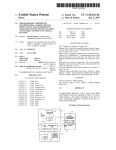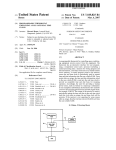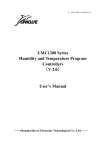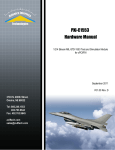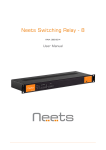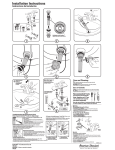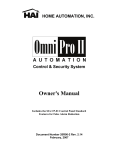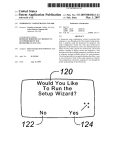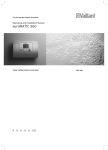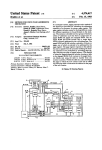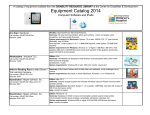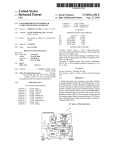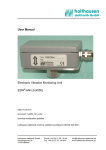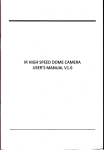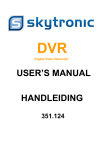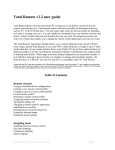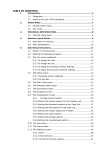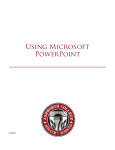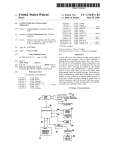Download Programmable thermostat incorporating a display screen selectively
Transcript
US007028912B1 (12) United States Patent (54) (10) Patent N0.: (45) Date of Patent: PROGRAMMABLE THERMOSTAT INCORPORATING A DISPLAY SCREEN SELECTIVELY PRESENTING SYSTEM MODES THAT INCLUDES A SIMPLE MODE (76) Howard R0sen, Lyncroft Road, Hampstead, Quebec (CA) H3X 3E3 Subject to any disclaimer, the term of this patent is extended or adjusted under 35 1 0/878,825 (22) Jun. 28, 2004 Apr. 18, 2006 6,285,912 B1 6,330,806 B1 9/2001 Ellison 12/2001 Beaverson 6,344,861 B1 2/2002 Naughton 6,478,233 6,595,430 6,621,507 2004/0245352 2004/0262410 2005/0154496 2005/0194457 B1 11/2002 Shah B1 7/2003 Shah B1 9/2003 A1* 12/2004 A1* 12/2004 A1* 7/2005 A1* 9/2005 FOREIGN PATENT DOCUMENTS U.S.C. 154(b) by 82 days. (21) US 7,028,912 B1 DE EP W0 W0 3334117 0985994 WO 97/11448 WO 97/39392 4/1985 3/2000 3/1997 10/1997 Related US. Application Data OTHER PUBLICATIONS (63) Continuation-in-part of application No. 10/654,235, ?led on Sep. 3, 2003. ADI, “Leopard User Manual,” 93 pages, 2001. Business Wire, “Micro Touch Specialty Products Group to Capitalize on Growing Market for LoW-Cost Digital Matrix (52) US. Cl. (58) Field of Classi?cation Search .............. .. DeKoven et al., “Designing Collaboration in Consumer Products,” 2 pages, 2001. Freudenthal et al., “Communicat ing extensive smart home functionality to users of all ages: the design of a mixed-initiative multimodal thermostat interface,” pp. 34-39, Mar. 12-13, 2001. Touchscreens,” p1174 (2 pages), Jan. 6, 1999. (51) ...................... .. 236/1 C; 236/94; 345/173; 700/276 236/1 C, 236/94; 345/173; 62/126,129; 165/111; 700/276 See application ?le for complete search history. (56) (Continued) Primary ExamineriMarc Norman (57) References Cited ABSTRACT A programmable thermostat, With a touch screen liquid U.S. PATENT DOCUMENTS crystal display having the capability to change from a more complex ?rst mode display to a simple mode display for users With adaptive, learning or visual impairments that limit 9/1980 4/1989 2/1992 12/1992 10/1998 5/2000 2/2001 their ability to use the relatively complicated user interfaces of prior art programmable thermostats. 16 Claims, 11 Drawing Sheets MEMORY /8 / 1 f9 / SPACE CONDITIONING EQUIPMENT CPU 6 \III Y\|I| 5‘ INPUT/OUTPUT UNIT S CONDITIONED SPACE 41 11 f LIQUID / TOUCH CRYSTAL DISPLAY 12) 3 US 7,028,912 B1 Page 2 OTHER PUBLICATIONS Honeywell News Release, “HoneyWell’s NeW Sysnet Facili ties Integration System For Boiler Plant and Combustion Safety Processes,” 4 pages, Dec. 15, 1995. HoneyWell, “W7006A Home Controller GateWay User Guide,” 31 pages, Jul. 2001. “High-tech options take hold in neW homesi200-08 28iDallas Business Journal,” http://biZiournals.com!dal las/stories/2000/08/28/focus4, 3 pages, dated Aug. 28, 2000, printed Aug. 19, 2004. “Product ReVieWiPhilips Pronto Remote Control,” http:// hometheaterhi?com/Volume 62/ philipsprontoremotecontrol.html, 5 pages, dated May 1999, printed Aug. 20, 2004. http://WWW.cc.gatech.edu/computing/classes/cs675l 94 fall/ 2roupc/climate-2/node l .html, “Contents,” 53 pages, printed Sep. 20, 2004. “HAI Company Background,” http://WWW.homeauto.com/ AboutHAI/abouthai main.htm, 2 pages, printed Aug. 19, 2004. Cardio Manual, available at http://WWW.secant.ca/En/ Documentation/Cardio2é-Manual.pd? Cardio Home Automation Inc., 55 pages, printed Sep. 28, 2004. “RC X10 Automation Forum: Control your Heating and Cooling System With Pronto(l/ 1),” http://WWW. remotecentral.comlcgi-binlmboardlrc-X l 0/thread.c~i? l2, 2 pages, dated Apr. 23, 1999, printed Aug. 20, 2004. * cited by examiner U.S. Patent Apr. 18, 2006 Sheet 1 0f 11 /8 1h / US 7,028,912 B1 1 3 MEMORY CLOCK / ['9 SPACE CONDITIONING EQUIPMENT CPU 6\ 10\ 27k % 5‘ INPUT/OUTPUT UNIT LIQUID / h8 SPACE 1 f2 FIG. 1A CRYSTAL TSXSH / 1 CONDITIONED 4 K11 7\ 1 DISPLAY 12) 104 103 /// \\ FIG. 1 100 109 101 102 U.S. Patent Apr. 18, 2006 Sheet 2 0f 11 US 7,028,912 B1 107 107 108 FIG. 3 111 110 \nnnn r'lnnn) U.S. Patent Apr. 18, 2006 US 7,028,912 B1 Sheet 3 0f11 116 /139 /oc 24.5 117 #525253 / 118 ‘223w ‘ \ F|G.6 120 121 119 F|G.7 122 / 124 116 \ PROG AUTO 123 _% 183 24 5° JV» I COOL 24.0 //m / HEAT 11.5 // \ \ 125 126 127 128 129 U.S. Patent Apr. 18, 2006 Sheet 4 0f 11 US 7,028,912 B1 122 132 \ FIG. 8 RUN \ PROG m o w 24.5c m 021: 50:: 137 122 / \ RUN m 138 / TOUCHWINDOW T0 CONFIRM FIG. 9 COOL m 24.0 HEAT : 21.5 n 122\ RUN F|G.10 116 \ m /m 24 . 5°C CO0L24.0 118//60/24/o3 4:03PM 121 U.S. Patent Apr. 18, 2006 140 1 41/ / 142 143 144 Sheet 5 0f 11 US 7,028,912 B1 FIG. 11 149 DATEITIME SETTINGS ADVANCED II/148 SETTINGS PROGRAM VACATION SETTINGS SETTINGS ENERGY WATCH FILTER II I MONITOR CLEAN SCREEN / 150 INSTALLER ENERGY 151// WATCH 152/ 153/ " SECURITY ! - - ¢ - 156 SETTINGS 157 DEAD BAND 1 58 FURNACE I . MESSAGE OFF 154/ A J 170 164 / ELECTRIC 159 \ FURNACE EIVIER. ELECT. AIR CONDITIONER NO COMPRESSOR HG 12 FURNACE GAS FURNACE OIL FURNACE FURNACE OFF 169 U.S. Patent Apr. 18, 2006 US 7,028,912 B1 Sheet 6 0f 11 \ E; m COMPRESSOR KW / 174 / 175 //m 171 [Kw FIG. 13 177 5 LAST 30 DAYS / 2o 178/ 55 176 KWH COMP / KWH FURN. 179 // 5 KWH FAN // so 180 / COST KWH TOTAL 120.53 181 / FIG. 14 \ 182 U.S. Patent Apr. 18, 2006 fLlUT-JLJU / / Sheet 7 0f 11 US 7,028,912 B1 113 ULIULIU‘ / 111 I 24.51:) L ' HEATH} 113A ‘Ell-Inn rlnnn 4 f I / \ I] FIG. 15 C :r?/E 3 D:l E C / 24 . 5°C HEATILS 06I24I03 I :l FIG. 16 PROG J 9385311 110% E E :I I I: C k FULILILILI / 111 / 155 UULVLILI\ / I INSTALLER MESSAGE ENERGY SECURITY’ WATCH SETTINGS DEAD 1 m NO COMPRESSOR 155A FURNACE OFF 3 INSTALLER ' MESSAGE ENERGY WATCH SECURITY SETTINGS DEAD BAND FIG. 18 fu N0 FURNACE COMPRESSOR OFF LI'T- U.S. Patent Apr. 18, 2006 \ a Sheet 8 0f 11 US 7,028,912 B1 / PROG 2 4 . 5 C° % HEAT 21.5 COOL 24.0 06/24/03 4:03PM 189 FIG. 19 1 86 190/ AUTO r/188 6 MIME! I ~//187 / Q w 24.50 1 91 HEAT 21.5 c001 24.0 06I24I03 4:03PM 102m FIG. 20 U.S. Patent Apr. 18, 2006 Sheet 9 0f 11 US 7,028,912 B1 112 122 \\ / ’ PROG m o w 24.50 m COOL 24.0 HEAT : 21.5 a /112 WITHIN TOUCH SCREEN 30sec. TO START 0 SIMPLE MODE /‘ U.S. Patent Apr. 18, 2006 Sheet 10 0f 11 US 7,028,912 B1 252 \ 251 \ 141 7254 H 24 l] 256 l /’w COOK 257 FIG. 23 \ 253 \ 255 259 \ n's NOW EJ\ 261/’ @ 263 DECREASE / 24.58 ACSET 141 \ \ TO START ABOVE 24.05 \\26<> 262 FIG. 24 U.S. Patent Apr. 18, 2006 Sheet 11 0f 11 US 7,028,912 B1 I START AT PROGRAM RESET, DEVICE POWER UP, 0 OR FROM CONTROL PROGRAM. DISPLAY SIMPLE MODE 2 ACTIVATION NOTICE HAS TOUCH SCREEN BEEN PRESSED IN TIME 1? DISPLAY AND OPERATE RETURN TO OTHER CONTROL PROGRAM 8 UNDER SIMPLE MODE FIG. 25 6 US 7,028,912 B1 1 2 PROGRAMMABLE THERMOSTAT INCORPORATING A DISPLAY SCREEN SELECTIVELY PRESENTING SYSTEM MODES THAT INCLUDES A SIMPLE MODE some modern thermostats, “virtual” buttons are presented on the LCD itself Which is juxtaposed With a touch pad to effect an interactive touch screen. There is a fundamental problem With the prior art pro grammable thermostat systems: they are dif?cult to program CROSS-REFERENCE TO RELATED APPLICATIONS to the extent that some users are unable to successfully program them. This is because the user interfaces Which have been employed in prior art programmable interfaces This application is a continuation in part of pending US. patent application Ser. No. 10/654,235 ?led Sep. 3, 2003. 10 “PROGRAMMABLE THERMOSTAT INCORPORATING A LIQUID CRYSTAL DISPLAY SELECTIVELY PRE SENTING ADAPTABLE SYSTEM MENUS INCLUDING CHANGEABLE INTERACTIVE VIRTUAL BUTTONS”. are not highly intuitive. Programmable thermostat systems have incorporated ?xed position real or virtual buttons, at least some of Which have multi-functions depending upon the point Which a user has reached in the programming process. The user must usually refer to and attempt to decipher a programming manual (Which is often dif?cult for the average user to readily understand) as the programming FIELD OF THE INVENTION proceeds. But, the programming process is so complex to folloW While trying to remember the instructions that many users give up, and the full capabilities of the thermostat The present invention relates to a programmable thermo stat incorporating an interactive liquid crystal display (LCD) or other display screen, and, more particularly, to such a 20 thermostat in Which the display screen selectively presents a system cannot be utiliZed. Outside of the art of programmable thermostat systems and programmable thermostats, dot matrix LCDs, Which have pixel display elements arranged in roWs and columns, more complex mode of information or operation and an alternate simpler mode of information or operation, in order are Widely used. Dot matrix LCDs are not common as to simplify a user interface With the programmable thermo user-visible displays on programmable thermostats for vieW stat. 25 ing alphanumeric and iconic graphic information although such a thermostat is disclosed in, and particular features BACKGROUND OF THE INVENTION Thermostats have been used for many years as tempera ture sensitive sWitches Which control heating and/ or cooling equipment for conditioning a space in Which the thermostat, claimed in, co-pending US. patent application Ser. No. 10/440,474, ?led May 15, 2003, and entitled: “Reverse Images in a Dot Matrix LCD for an Environmental Control 30 or a temperature sensor connected to the thermostat, is placed. In the Well knoWn manner, a simple thermostat can be adjusted to establish a temperature set point such that, When the temperature in the conditioned space reaches the set point, the thermostat interacts With the heating and/or/ cooling equipment to take suitable action to heat or cool the 35 thermostats is because of basic engineering and practical considerations. Displayed information for a programmable thermostat generally includes such things as environmental conditions, heating and/or cooling equipment operation or non-operation, operational modes of the thermostat and the like. The most important information in thermostat displays conditioned space as may be appropriate for the season as established by a user. Modern thermostat systems, Which take advantage of the Device” by HoWard B. Rosen, incorporated by reference herein. This limited use of dot matrix LCDs in programmable is capable of being formed from segmented alphanumeric 40 characters on less expensive LCDs Without dot matrix ongoing rapid advances in electronic technology and circuit integration, have many features Which provide more precise supervision of the heating and/or cooling equipment to programming. achieve more economical and more comfortable manage art user programmable thermostats through a failure to ment of the temperature of a conditioned space. Many modern thermostat systems include a real time clock, a capability and With reduced requirements for memory and Thus, dot matrix LCDs have not been Widely used in prior 45 understand an extended functionality capability of those devices When dot matrix LCDs are employed With a touch pad to effect an interactive display. This extended function memory and a data processor to run a process control program stored in the memory; Such thermostats accurately ality is exploited to advantage in the present invention both measure the temperature of a temperature sensor disposed in the conditioned space and make decisions to send control to greatly simplify user programming and to relieve the manufacturer of the necessity to fabricate variants of the thermostat to suit the control and display aspects of various 50 signals to the heating and/or cooling equipment in order to closely control the temperature of the conditioned space. The use of programmed thermostat systems permits antici pating and minimizing hysterisis or overshoot of the tem perature in the conditioned space. In addition, the program can specify different set points at different times of the day heating and/or cooling environments. 55 ing skills, poor vision and others in similar circumstances. Devices such as programmable thermostats, desktop com puters, programmable VCR’s, and even programmable and Week and may also include a “vacation” mode Which employs different set points When the conditioned space is not occupied for an extended period. Many modern thermostat systems are programmable by a It is Well knoWn that information or operational interfaces of programmable thermostats can be incomprehensible or overly challenging to many users With advanced age, leam clock radios often lie un-used in an oWner’s home because user. Typically, prior art programmable thermostat systems of fear of the complexity of such devices. More speci?cally, programmable thermostats generally comprise a user inter employ a set of ?xed position, button-actuated sWitches to be depressed in a precise sequence to program set points face that use a mixture of raised push buttons With repre sentations of environmental sensor information and control 60 data on a segmented liquid crystal display. (Which may vary With the day of the Week) for program mable time periods Which may include a vacation mode. The programming sequence may be folloWed on a separate display, typically an LCD With segmented text characters. In 65 In a modern programmable thermostat, a user is most often challenged With a ?rst set of push buttons that lie outside of hinged cover and a second set of buttons that lie US 7,028,912 B1 3 4 behind that hinged cover. External push buttons are usually SUMMARY OF THE INVENTION those that a user Will most often use to make simple program changes While the covered push buttons are lesser used buttons representing lesser used and usually more complex programming options. A user cannot by intuition selectively pick Which push buttons represent thermostat program func provided by a programmable thermostat system for control ling space conditioning equipment and Which includes: a transparent touch pad juxtaposed With an LCD (preferably tions that are critical to a user and Which buttons are of little dot matrix) to constitute a touch screen for interactive consequence. A user With limited learning or vision skills typically learns to use a feW of the push buttons on a modern interface With a user; one or more environmental condition programmable thermostat to run heating and air condition one or more sensed environmental conditions of a condi ing operations and may literally live in fear of the rest. Covering buttons With a physical cover that is easily opened tioned space; and a processor including: a central processing unit, a real time clock, a memory coupled to the central does not help such a user. Such a user suspects that they Will never be able to understand Whether their heating or air processing unit for storing program and data information and an input/output unit coupled betWeen the processor and conditioning is running the Way they Want it to operate. Thus, the HoneyWell Corporation still sells a signi?cant the touch screen for carrying out information transfer ther ebetWeen. A program stored in the memory directs the central Brie?y, these and other objects of the invention are sensors for providing an electrical signal indicative of the number of round, rotation-operated thermostats With no push buttons or display screen, a design that is almost 50 years old. While limited in function to just changing set points for heating or air conditioning, older users are con processing unit to communicate through the input/output 20 ?dent that they understand the operation of the thermostat and their heating and air conditioning systems. There is a need for a programmable thermostat that can give a user With limited learning or restricted a simple interface, an interface Without a confusing mix of raised push buttons and environmental sensor information and control data in vari 25 ous arrangements on a segmented LCD. a virtual button. Di?ferent menus can place the virtual 30 OBJECTS OF THE INVENTION It is therefore a broad object of this invention to provide a ?eld programmable thermostat Which is very easy for a user to program. It is an improved broad object of this invention to provide a ?eld programmable thermostat Which gives the user an option to display a simple mode of information and/ or operation. It is another broad object of this invention to provide a 35 40 may have limited learning skills or impaired vision. 45 programmable thermostat in Which a one or more user interfaces are entirely displayed on an LCD With a touch screen functionality, Where one of those user interfaces is a easier and more intuitive and also obviates the need for the manufacturer to fabricate and market multiple models of thermostats with different virtual buttons. Thus, an image representative of a ?rst virtual button may be shoWn on the touch screen display With graphics (alpha numeric characters and/or icons) on or closely associated With the ?rst virtual button. The characters/ graphics associ ated With the ?rst virtual button indicate, for example, a current operating state or condition of the programmable thermostat. A user touching the ?rst virtual button causes the simple mode. The simple mode provides a simple user 50 device program to change the operating state or condition, and the graphics on the touch screen display also change to indicate the changed operating state or condition. As an example, a ?rst virtual button may be associated With the Word “COOL” to indicate to a user that the 55 programmable thermostat Will only operate in an air condi tioning mode. In the prior art, touching the ?rst virtual button Will shift the programmable thermostat from the air conditioning mode to, for example, a heating mode such that the associated text Would change to “HEAT”. HoWever, in accordance With the invention, if the user has no heating to operate heating and/or cooling setpoints for HVAC equip ment. In another speci?c form, the invention comprises a simple mode operating to display on an LCD items of information and touch screen buttons highly magni?ed for a vision impaired user. The simple mode in one form of the display during preliminary programming depending on the type(s) of environmental control equipment a user actually has connected With a programmable thermostat. This feature makes ongoing user programming and system management ?eld programmable thermostat Which may be user-con?g interface on the LCD. The speci?c embodiments beloW provide additional details, but “simple” herein means that a displayed user interface comprises feWer items of informa tion or representations of buttons responsive to a user’s touch than any of the other display modes of the program mable thermostat. In a speci?c form, the invention com prises a simple mode operating to display on an LCD only those items of information and touch screen buttons needed buttons and messages in various positions on the touch screen to facilitate intuitive programming. In accordance With one aspect of the invention, environ mental control selection virtual buttons are added to or eliminated from at least some menus of the operational ured to limit information and/ or functionality for a user Who It is a more speci?c object of this invention to provide a criteria. An alphanumeric message explaining the function of the virtual button is also displayed, and icon indicators may be employed to unmistakably associate a message With While the present invention may be practiced using segmented LCDs, it is preferably embodied using dot matrix LCDs. unit to selectively: establish on the LCD a representation of at least one virtual button at a predetermined XY position; read the same XY position on the touch pad to determine if the virtual button has been touched; and if the virtual button has been touched, perform a predetermined action such as moving to a different menu and/or changing operating 60 equipment connected With the programmable thermostat, that fact Will have earlier been entered into memory With a menu selection at a different touch screen display during invention is made available to a user in a simple manner. preliminary programming. After that earlier entry indicating When the programmable thermostat program is reset or that no heater is connected With the programmable thermo stat has been made, any user selecting an operating state or condition Will not be shoWn any virtual button indicating that a heating mode is available. poWered up after being turned olf, the LCD provides rep resentations notifying the user to press the LCD at any location to initiate the simple mode. 65 US 7,028,912 B1 5 6 Thus, after a simple, one-time, designation of the envi ronmental control equipment installed in a given system FIG. 14 is an exemplary pictorial of a third menu inter active interface displayed on the touch screen for the using easy to understand menus, any subsequent user Will “energy Watch” mode; only have to interact With ?rst virtual buttons representing the actual environmental control equipment under control. It displayed on the touch screen of FIG. 8 as vieWed in the may be noted that this feature of the invention also alloWs a user to eliminate virtual buttons (and the associated envi device of FIG. 5 disposed in a horizontal mounting position; FIG. 16 is exemplary pictorial of the text and graphics of ronmental control functions) available at ?rst interaction the interactive interface displayed on the touch screen of FIG. 8 rotated for the device of FIG. 5 disposed in a vertical FIG. 15 is exemplary pictorial of an interactive interface screens for the programmable thermostat even if the “elimi nated” control equipment is actually installed and connected With the programmable thermostat, thereby adding a level of mounting position; security against use of thermostats one user Wants to pre displayed on the touch screen of FIG. 12 as vieWed in the clude from use by others. device of FIG. 5 disposed in a horizontal mounting position; FIG. 18 is exemplary pictorial of the text and graphics of FIG. 17 is exemplary pictorial of an interactive interface the interactive interface displayed on the touch screen of FIG. 12 rotated for the device of FIG. 5 disposed in a vertical DESCRIPTION OF THE DRAWING The subject matter of the invention is particularly pointed out and distinctly claimed in the concluding portion of the speci?cation. The invention, hoWever, both as to organiZa tion and method of operation, may best be understood by reference to the folloWing description taken in conjunction With the subjoined claims and the accompanying draWing of position; and FIGS. 19 and 20 illustrate the manner in Which different ?rst level interface screens may be revieWed and selected. 20 Which: FIG. 1A is a block diagram of a space conditioning system incorporating a programmable thermostat according to the 25 present invention; FIG. 1 is a partially cut aWay schematic and top vieW of a thermostat With a backlit dot matrix LCD employed as a display; 30 FIGS. 2 and 3 particularly illustrate a magni?ed section of FIG. 21 is the vieW of FIG. 8 illustrating a ?rst display mode of the control program. FIG. 22 is an exemplary pictorial of a simple mode activation notice. FIGS. 23 and 24 are exemplary pictorials of user inter faces represented on an LCD When the control program is in a simple mode. FIG. 25 is a process How chart illustrating a part of the thermostat control program by Which a simple mode acti vation notice and a simple mode user interface are displayed on an LCD of the programmable thermostat. the thermostat showing tWo forms of displaying contrast in DETAILED DESCRIPTION OF THE a dot matrix LCD; FIGS. 4 and 5 are perspective and front vieWs, respec PREFERRED EMBODIMENT(S) tively, of an exemplary touch screen programmable thermo stat of the present invention; FIG. 6 is an exemplary pictorial of a ?rst level interactive interface displayed on the touch screen; FIG. 7 is an exemplary pictorial of a second level inter active interface displayed on the touch screen shoWing exemplary alternate contrast for a touch screen virtual 35 temperature sensor 5 Which is disposed in a conditioned space 4. It Will be understood that the processor 1 and the touch screen 2 are typically situated in a common housing 40 housing is usually, but not necessarily, placed in the condi FIG. 8 is an exemplary pictorial of a second level inter 45 upon touching a single virtual button; FIG. 9 is an exemplary pictorial of the second level interactive interface displayed on the touch screen in FIG. 8 With a temporary “con?rmation” virtual button for accepting the change of the single virtual button; 50 process control program and a random-access part Which stores data subject to change during operation. A settable 55 FIG. 11 is an exemplary pictorial of a menu displayed on real time clock 13 is used to keep time in the thermostat system to facilitate diverse operations, such as establishing different temperature set points (desired temperatures), dur ing different periods of the day cycle. An analog-to-digital converter 27 (Which may not be required in all systems) 60 “ADVANCED SETTINGS” menu selections after the “ADVANCED SETTINGS” virtual button of FIG. 11 has serves to convert any analog information received by the I/O unit 10 to digital information Which is suitable for use by the CPU 9. The thermostat system may be suitably poWered by a battery (not shoWn) and/or from equipment to Which is been touched; FIG. 13 is an exemplary pictorial of yet another interac tive interface, reached by touching an “ENEGY WATCH” virtual button displayed on the touch screen, for entering settings for an “energy Watch” mode; program information and also, via an input/output unit (I/O unit) 10, a touch pad 11 and an LCD 12 Which together read-only part Which is factory-programmed to include the the touch screen to provide a ?rst set of menu selections including an “ADVANCED SETTINGS” virtual button; FIG. 12 is an exemplary pictorial of another interactive interface displayed on the touch screen shoWing tioned space 4. Thus, those skilled in the art Will understand that the block diagram of FIG. 1A is very general in order to best explain the invention. The processor 1 includes a central processing unit (CPU) 9 in communication With a memory 8 for storing data and constitute the touch screen 2. The memory 8 may include a FIG. 10 is an exemplary pictorial of a second level interactive interface displayed on the touch screen in FIG. 8 With the function changed from “AUTOMATIC” to “COOL”; (shoWn in an exemplary form in FIG. 5). The sensor 5 may also be situated in the common housing or remotely as shoWn, all as very Well knoWn in the art. The common button; active interface displayed on the touch screen With an exemplary sequence of virtual buttons available to a user Referring ?rst to FIG. 1A, a user programmable thermo stat system includes a processor 1, a touch screen 2 and a 65 connected. Temperature information from the sensor 5 and output signals to a space conditioning (heating and/or cooling) unit 3 pass through the I/O unit 10 under control of the CPU 9 US 7,028,9l2 B1 7 8 executing the process control program stored in the memory 8. Those skilled in the art Will understand that if the correspondents external to the processor 1 communicating With the CPU 9 are all digital in nature (e.g., if the tem perature sensor 5 incorporates its oWn analog-to-digital converter and sends a digital representation of temperature to the processor 1), then the I/O unit 10 may only constitute connected to poWer and to processor 101 so that it can be turned on or off as needed or desired. The processor 101 also optionally includes a light sensor (not shoWn) for sensing the illumination level in the space in Which the LCD 104 is located, Which illumination may be compared With a previously entered minimum illumination value to determine Whether or not the room is darkened or simple sWitching circuits. The LCD may optionally be dimly lit. If so, the display image can be reversed to improve backlit by any suitable means (not shoWn in FIG. 1A). The heating/ cooling equipment unit 3 may include one or readability. Alternatively, as the processor 101 includes a real time clock, an image reversal can be instituted at more components such as a heater, a compressor-type air conditioner, a heat pump, etc. predetermined times of the 24-hour day. Thus, FIG. 2 shoWs section 106 operated as it Would typically appear during a daytime or lighted room condition. The display elements of surrounding section 107 are essen Thus, in the usual manner during normal operation, the temperature sensor 5 sends an electrical signal (e.g., if the types of temperature sensors are Widely used) representative tially clear and, optionally, backlight panel 103 shines through them to improve readability. The display elements of the temperature Within the conditioned space 4 Which the processor can compare against a previously entered set point to determine if control signals need to be sent to the space of image section 108 are partially or completely opaque during daytime or in a lighted space. The combination of image section 108 and surrounding section 107 therefore sensor 5 is a simple thermistor, a resistance value; several conditioning equipment 3. For example, if the temperature 20 displays system information readily comprehensible and in the conditioned space 4 is found to be too loW When legible to a user in a lighted room. operation is in the heating mode, the processor 1 signals the space conditioning equipment 3 to circulate, through ducts 6, 7, air from/to the conditioned space 4 Which is heated by FIG. 3 shoWs section 106 operated as it Would during nighttime or in a dimly lit room. The image has been reversed such that the display elements of the surrounding the space conditioning equipment before return to the con ditioned space. This heating phase continues until the sensor 5 indicates that the space is noW too hot (or approaching too hot) With reference to the set point such that the processor 1 sends signal(s) to the space conditioning equipment 3 to cease the heating function, all as very Well knoWn in the art. In a cooling mode, a counterpart procedure is folloWed. Those skilled in the art Will understand that the control process typically includes such re?nements as anticipation, hysterisis accommodation, fan control, etc. Which are acknowledged, but are not directly relevant to the invention. section 107 are noW partially or completely opaque, and light provided by backlight panel 103 is partially or sub stantially completely blocked. But, the display elements of image section 108 are noW essentially clear, and the light from backlight panel 103 shines through them. The current 30 operation is a dimmer display Which is suitable for loW lighting conditions. 35 It may be noted that integrated circuit chips including all the processor components With all the necessary interface conditioning circuits are available olf-the-shelf and are under constant re?nement for increased poWer. The subject invention only requires the capabilities of a processor such as the processor 1, and olf-the-shelf integrated circuit pro cessor chips may be used to advantage in the subject 40 mation of the programmable thermostat are available to a user by observation and interaction With the touch screen 45 user programmable. The present invention relates to pro grammable thermostat systems in Which, in the prior art, programming steps have been entered using a “tactile” touch pad While observing a display Which may be an LCD or some other display type. The draWbacks of the prior art interactive thermostats have been discussed above. The present invention employs a different type of thermostat user “heating mode active” display 118; and a “cooling mode active” display 121. Pictorial 113 displays the Word “AUTO” on virtual button 116 because the thermostat 110 is 55 is shoWn for illustration as separated from a backside of currently operating in an “automatic” mode to control both a heater and an air conditioner to respective setpoints shoWn in displays 118 and 121. Pictorial 113 is a ?rst level touch screen; i.e., a default ?rst screen that is normally vieWed by a user When ?rst 60 electrically coupled With multiple connections 102 to a dot matrix LCD 104 Whose individual pixels 105 are driven by suitable signals to their respective vertical columns and horizontal roWs from the processor 101. Backlight panel 103 LCD 104 although it is knoWn and preferred that these tWo components be in close contact. Backlight panel 103 is buttons 115, 116, 117; a “current temperature” display 139; a “date” display 119; a “current time” display 120; a and LCD 12 are integrated and coordinated as Will be very much easier to program than in the prior art. FIG. 1 shoWs a thermostat 100 having a processor 101 for controlling space conditioning equipment in a manner equivalent to the discussion above. The processor 101 is 112. In the example, the touch screen 112 is generally rectangular, thus having a long dimension and a short dimension. FIG. 6 shoWs a ?rst pictorial 113 presented on the touch screen 112 and including: a column 114 of interactive virtual 50 interface; viZ., the touch screen 2, in Which the touch pad 11 discussed beloW and Which, in conjunction With the proces sor 1, provides a programmable thermostat system Which is In another, similar, mode of operation, the reversible image can be repeatedly reversed to “?ash” all or selected items of the display upon the occurrence of certain condi tions as Will be described beloW. FIGS. 4 and 5 shoW an exemplary touch screen thermostat 110 With a housing 111 and touch screen 112 and incorpo rating the subject invention. Thermostat 110 has no physical buttons at all; rather, all the functions and displayed infor thermostat system. Thermostat systems may be user programmable or non system information is thereby comprehensible and legible to a vieWer in the darkened space. The result of this mode of approaching the thermostat 110. The information conveyed to a user, during normal system operation of the exemplary current con?guration shoWn in FIG. 6, are: current ambient temperature, current date and time, that a heater Will turn on With reference to a set point of 21 .5° C., that the air 65 conditioning system Will turn With reference to a set point of 24.00 C., that the thermostat 110 is operating in the “AUTO” mode Where both heating and air conditioning system com US 7,028,912 B1 10 because no heating function is active. Display 121 is still present in FIG. 10 because the “cool” mode is operational. Should the “heat” mode be selected and “HEAT” shoWn ponents are active and that the fan is responding to only the heating and air conditioning modes (i.e., not always run ning). With virtual button 116, display 121 Will disappear and display 118 Will reappear. In the “o?‘” mode, both displays 118 and 121 Will disappear. When a user touches any active part of the touch screen in pictorial 113, the overall display changes to pictorial 122, a second level touch screen shoWn in FIG. 7. Virtual buttons 115, 116, and 117 still perform the functions described It Will be appreciated that the virtual buttons of virtual buttons column 132 may alternatively be reduced in siZe and distributed on the surface of pictorial 113 instead of being a set of virtual buttons activated and serially vieWable by invoking steps 133*137. If the virtual buttons of virtual above. NeWly-presented virtual buttons 127 and 129 can be selectively touched at temperature displays 128, and 130, respectively, to adjust the minimum and maximum set points. FIG. 7 also illustrates that virtual button 116 may be touched and responsively changed in step 123 by the control buttons column 132 are distributed as separately and simul program to reverse contrast to be shoWn (in the same taneously vieWable virtual buttons, it is desirable that the virtual button for the function currently activated for ther position previously occupied by virtual button 116) as reversed contrast virtual button 124. In order to attract the user’s attention to this button position, reversals can be made in short intervals so that the virtual button 116 appears to be mostat 110 Will “?ash” in contrast as described above so that the user Will knoW Which of the operating states or condi tions are currently controlled by thermostat 110. HoWever, it is an important feature of the thermostat 110 ?ashing. This “?ashing” emphasiZes the fact that the ther mostat 110 is currently operating in a particular state or condition and that a user may Want to change the operating state or condition of the thermostat 110. Touching virtual button 183 directs the control system to another mode of 20 example, and their associated changes in the normal opera tion control effected by thermostat 110 may be available to operation Which Will be discussed further beloW. FIGS. 8 to 10 shoW pictorial 122 in various interactive conditions. FIG. 8 illustrates that virtual button 116 can undergo step 131 in response to a user touch Which also causes a change in the operating state of thermostat 110 and a user. The user has the ability to “edit” and/or simplify the virtual buttons column 132 to re?ect the user’s environmen 25 30 through the functions of thermostat 110 and the correspond ing legends Which may appear With virtual button 116. The particular sequence of thermostat functions available at steps 133 to 137 is only exemplary of hoW normal user changes 35 mostat 110; the virtual buttons of column 132 may, of virtual button 116 one or more times to cause the operating state of thermostat 110 and the legend of virtual button 116 to change With respect to those steps as folloWs: A) at step 137, from “automatic” mode to “o?” mode (none of the environmental control equipment con nected With thermostat 110 Will operate, and virtual betWeen operating states or conditions are made for ther course, have a different sequence and also re?ect various space conditioning equipment components Which may be installed in diverse applications. button 116 shoWs “OFF”); B) at step 133, from “o?” mode to “heat” mode (a heater or a heat pump in heat mode operates to heat the conditioned space, and virtual button 116 shoWs 40 “HEAT”); C) at step 134, from “heat” mode to “cool” mode (an air conditioner or heat pump operating in the cooling mode operates to cool the conditioned space, and virtual button 116 shoWs “COOL”); D) at step 135, from “cool” mode to “emergency heat” mode (a backup electric heater operates to keep the tal control equipment actually connected for control by thermostat 110. If feWer than or more than the virtual buttons of virtual buttons column 132 are available to the user, appropriate feWer or more touching steps Will be required to cycle a change of the legend associated With virtual button 116 to one of the virtual buttons in column 132. In the example, successive steps 133 to 137 indicate that a user has touched that, although a user may touch virtual button 116, feWer or more than all the virtual buttons of column 132, in the 45 Thus, as more fully described beloW, a user is able, typically during a system setup, to eliminate or add to the virtual buttons shoWn in column 132 (and their associated functions) by using the touch screen in a manner that alloWs the user to specify What environmental control equipment components are actually controlled by thermostat 110 and, accordingly, included in column 132. In practice, the thermostat manufacturer provides, in the control program, control sequences for as many different types of space conditioning components as might be used in Widely diverse applications, alone or in combination. During conditioned space temperature above a loWest set point, and virtual button 116 shoWs “EMER HEAT”); and E) at step 136, from “emergency heat” mode to “auto matic” mode (the air conditioner and heater (or heat pump) operates in both the “heat” and “cool” mode, and virtual button 116 shoWs “AUTO”). FIGS. 9 and 10 illustrate an exemplary operation of 50 changing, con?rming and shoWing the change made by 55 setup, the user of a given installation eliminates those components, and graphics displays related thereto, Which are irrelevant to the given installation, thus simplifying later ongoing programming and use of the thermostat. This sys tem setup procedure is instituted by touching the “MENU” button 183 shoWn in FIG. 7 Which the control program touching virtual button 116 tWice. FIG. 9 shoWs that, under responds to by displaying second-level pictorial 140 on the control of the process control program, virtual button 116 touch screen. has already responded to step 133 to brie?y change from the FIG. 11 shoWs that pictorial 140 displays virtual buttons “auto” mode to the “heat” mode on the ?rst touch and, on the 141 to 149. Touching each of buttons 141 to 149 results in a neW, usually third level, pictorial screen to shoW informa second touch, has changed from the “heat” mode to the “cool” mode; and that a temporary active virtual button 138 60 tion and/or neW buttons as folloWs: A) for “home” icon button 141, a return to the ?rst level, is noW displayed for a user to con?rm that the user Wishes normal operation, pictorial 113 shoWn in FIG. 6; to select the currently displayed function; i.e., “cool”. Touching virtual button 138 under these conditions causes the changes seen in FIG. 10. It Will be particularly noted in FIG. 10 that, as a feature of the system, display 118 has disappeared since the “auto” mode is no longer operational 65 B) for “DATE/TIME SETTINGS” button 142, for enter ing current date and time information; C) for “SET SCREEN” button 145, for changing screen settings for the touch screen; US 7,028,912 B1 11 12 Pictorial 155 of FIG. 12 also shoWs virtual button 151 for D) for “CLEAN SCREEN” button 146 to Wipe the screen, e.g., With a lightly dampened cloth, Without acciden changing the temperature designation in the touch screen from Centigrade to Fahrenheit, buttons 153 and 157 for entering certain set point related parameters, button 155 for entering an installer message and button 146 for entering tally changing any of the settings; this function times out after a feW seconds; E) for button “FILTER MONITOR” button 147, entering, for display at pictorial 113 or similar touch screen, a reminder to change or clean ?lters on a speci?ed security settings. schedule; touching button 152 of FIG. 12. Pictorial 171 is a menu FIG. 13 shoWs pictorial 171 Which is activated by a user’s permitting entry of energy requirement and cost information using cost determination information entry virtual buttons 172, 173, 174 and 175. Touching button 172 changes the numerical legend in increments to indicate kilowatts per hour required of a compressor if air conditioning equipment F) for “VACATION SETTINGS” button 148, for entering appropriate vacation system settings; G) for “PROGRAM SETTINGS” button 143, for entering automatic temperature set point adjustments, typically for each of four selectable times for each day of the is present. Thus, the user is able to enter into the energy Week; required for operation of a cooling component in the system. H) for “ENERGY WATCH” button 144, for display of In a similar manner for buttons 173 and 174, a user can enter ongoing energy consumption and costs as discussed further beloW; and I) for “ADVANCED SETTINGS” button 149, for enter ing the environmental control equipment connected With thermostat 110, entering energy consumption data the energy requirements for a heating fumace or heat pump if in the system and that of a system fan. Button 175 alloWs the user to enter the per kiloWatt hour cost of energy in the 20 user’s locality. The equipment energy requirements and 25 energy cost are stored in the memory and used by the control program to calculate and display cumulative energy used and cumulative cost of that energy for a monitored period. The memory stores in a cumulative amount the periods in Which the air conditioner, fumace, heat pump, fan and/or and costs and other functions as described. Touching virtual button 149 results in display of pictorial 150 of FIG. 12. In a manner similar to button 116 of FIG. 8, buttons 154 and 158 of FIG. 12 each represents a sequence of buttons that change after being touched by a user. Button 154 represents the presence or absence of air conditioning equipment connected With thermostat 110. Button 158 rep resents the presence or absence of heating equipment con nected With thermostat 110. More particularly, the virtual buttons in column 163 are 30 those that become successively visible When a user succes sively touches button 154, also indicating a change in the designation of Which cooling equipment is present in a given system. Similarly, in the example, buttons in column 164 are and the total cost of that energy shoWn in display 182. 35 those that become successively visible When a user succes given system. at button 154 from “heat pump” mode to “air conditioner” mode, from “air conditioner” mode to “no compressor” mode (no air conditioning equipment), and from “no com pressor” mode to “heat pump” mode. The memory program contains programming adapted to cause effective operation of a heat pump or compressor type air conditioner depending on the one selected at button 154. If the “no compressor” mode is selected at button 154, the buttons column 132 of FIG. 8 Will lack the “cool” and “auto” buttons and functions. 40 45 Attention is noW directed to FIG. 15 Which shoWs that displays disposed horizontally for easy reading, as does the 50 same alphanumeric text on the same buttons and displays in pictorial 113A of FIG. 16. HoWever, the housing 111 ofFIG. 15 has been rotated 90 degrees to obtain the vertical orien tation of the housing 111 of FIG. 16. The control program of thermostat 110 can reorient the display from that shoWn in 158 from “electric furnace” mode (presence in the given system of an electric poWered furnace) to “emer. elect. nace” mode. If the “fumace o?‘” mode is selected at button 158, the buttons column 132 of FIG. 8 Will lack the “heat” and “emer heat” mode buttons and functions as Well as the “auto” mode button and function. The control program stored in memory contains routines adapted to cause effec that a single button touch at the ?rst level interface Will bring the touch screen directly to the display of FIG. 14. pictorial 113 has alphanumeric text on the buttons and tively cause a change in the function and legend at button furnace” mode (additional presence of an emergency electric touch: an active part of the touch screen of pictorial 113 of FIG. 6, the “MENU” button 183 of pictorial 122 of FIG. 8 and the “ENERGY WATCH” button 144 of pictorial 140 of FIG. 11 to arrive at the display of FIG. 14. Alternatively, the “ENERGY WATCH” button 144 can instead or also be provided on the touch screen of pictorial 113 of FIG. 6 so Cycling through steps 165, 166, 167, 168 and 169 respec furnace), from “emer. elect. fumace” mode to “gas fumace” mode (presence of a gas fumace), from “gas fumace” mode to “oil furnace” mode (presence of an oil fumace), from “oil furnace” mode to “furnace o?‘" mode (lack of heating equipment) and from “furnace o?‘” mode to “electric fur It Will be understood that the user, With a feW button manipulations, can easily determine What the running cost is for the use of the environmental control equipment in the user’s system. In the example, the user can successively sively touches button 158, also indicating a change in the designation of Which heating equipment is present in the In the example, invoking steps 160, 161 and 162 respec tively cause a change in the function and legend appearing other environmental control equipment operates, and calcu lates and displays, as shoWn in pictorial 176 of FIG. 14 the running energy cost information. In the example, display 177 shoWs the number of days for Which the energy infor mation has been accumulated. Displays 178, 179, 179, and 180 shoW energy used by respectively and cumulatively the air conditioning compressor, the fumace and the fan, With the total energy being used by that equipment in display 181 55 pictorial 113 to that shoWn in pictorial 113A by suitably remapping the column and roW drive signals to the indi vidual pixels of the LCD. This feature can be invoked, in one 60 embodiment, by touching the “SCREEN SET” button 145 of pictorial 140 shoWn in FIG. 11 for a predetermined period of time (say ?ve seconds), Which action is sensed by the control program to cause a change of pictorial 113 to pictorial 113A or vice versa. All the pictorials for the touch screen for the thermostat 110 Would be similarly reoriented, and FIGS. 17 and 18 shoW a similar translation of pictorial 155 to pictorial tive operation of any combination of the designated equip 155A. This feature is not limited to a translation of only 90 ment. degrees of the alphanumeric text, graphics and buttons of 65 US 7,028,912 B1 13 14 thermostat 110 as described above. The memory program, columns, can cause a rotation of all those aspects of the An improvement embodiment is noW described With reference to the above user interfaces selectable according to the user’s needs. A user of a programmable thermostat may have limited touch screen to be rotated incrementally through 360 ability to learn, adapt to, or visually perceive What are combined With the capability of a dot matrix type LCD, With its individually addressable pixels disposed in roWs and degrees so that a user can mount the housing 111 in Whatever standard user interfaces on prior art programmable thermo angled orientation is desired. stats. Described above are several forms of entire user interfaces provided on a single LCD of a programmable Attention is noW directed to FIG. 19 in Which pictorial thermostat, Where the user interface comprises text, graph ics, and representations of programming touch screen but 184 is obtained by touching the “SET SCREEN” button 145 of pictorial 140 shoWn in FIG. 11 for a predetermined period tons, as in FIG. 21. It is an object of this embodiment to of time (say ?ve seconds). This touching action is sensed by simplify the user interfaces of programmable thermostats that have been designed for more adaptive or visually the control program Which causes a display change from pictorial 140 shoWn in FIG. 11 to the pictorial 184 shoWn in FIG. 19. Pictorial 184 contains a sub-pictorial 185 that is a framed and generaliZed inactive version of ?rst level inter active pictorial 113 shoWn in FIG. 6. The user sees in accomplished persons. The present embodiment provides for a simpler user interface. The present invention has moved much or all of its user interface to an LCD touch screen, thereby dramatically reducing the visual challenge of associating raised push sub-pictorial 185 a general layout of virtual buttons, text and graphics that can be selected to vieW as the pictorial of the ?rst level interactive interface. This user selection can be 20 nates representations of information and/or functions from made if the “SET SCREEN” button 145 of pictorial 184 shoWn in FIG. 19 is not touched for a predetermined period of time (say ?ve seconds). HoWever, the user can select other an LCD that Would confuse or be of little use to the general layouts of virtual buttons, text and graphics that Will thereafter be seen at the ?rst level interactive interface. 25 Thus, referring noW to FIG. 20. pictorial 186 contains a sub-pictorial 187 that is an alternate general layout of virtual buttons, text and graphics for the ?rst level interactive interface that can be selected by a user. Sub-pictorial 187 appears if virtual button 145 is touched for a predetermined 30 period of time (say ?ve seconds). In sub-pictorial 187, a roW of virtual buttons 191 are aligned along a top part of sub-pictorial 187 Which Will become the ?rst level interac tive interface shoWn in FIG. 8 When normal operation is buttons With representations on an LCD of a programmable thermostat. This embodiment takes a further step and elimi handicapped user. A display on a programmable thermostat LCD as oper ating in a ?rst mode is similar to that shoWn in FIG. 21. FIG. 21 shoWs that LCD 112 presents a ?rst mode pictorial 122. Pictorial 122 comprises touch screen buttons such as RUN PROG and MENU can be intimidating to a handicapped user. A simple mode exists in the control program that causes a change in representations on the LCD. In one form of the embodiment, the simple mode is selectable in a manner similar to Way other user interfaces are caused to be dis played and as described above. In an initial installation, an experienced installer can select the simple mode for the resumed. When a return is made to the alternative ?rst level handicapped user. In a preferred form of the invention, a handicapped user interactive interface, touching any one of the virtual buttons 191 causes the control program of the thermostat to change can cause the control program to initiate and operate the operating states to one associated With that one virtual button. In one embodiment, a touched virtual button 191 is visually distinguished from the other virtual buttons 191 so the user knoWs Which operating state currently controls the thermostat. One form of effecting that visual distinction is shoWn for virtual button 188. Virtual button 188 after being touched causes the control program to change the operating 35 simple mode With a set of tWo interaction steps. FIG. 22 shoWs a pictorial 250 on touch screen 112 that contains 40 simple user instructions. Pictorial 250 is obtained by reset ting the control program, re-poWering the programmable thermostat, or by another similarly simple step. A represen tation of an interactive virtual button may be made in 45 pictorial 113 having text such as “simple mode” that Would cause the control program to present pictorial 250. Pictorial state of the thermostat to an “automatic” mode (the air conditioner and heater together, or a heat pump, operates in both the “heat” and “cool” modes, and virtual button 188 250 invites the user to press the touch screen 112 if the user shoWs “AUTO”). Thereafter, the visible representation of receives an input that touch screen 112 has be pressed Within virtual button 188 changes according to step 190 to the contrasting virtual button 189 and back to the form shoWn desires to operate the programmable thermostat in the simple mode. Upon taking such action, the control program 50 for virtual button 188 at short intervals to simulate a “?ash ing” virtual button. Virtual buttons 191 represent the same operating states represented by the similarly named virtual buttons of virtual buttons in column 132 shoWn in FIG. 8. a speci?ed time, thereby initiating operation of the simple mode. The simple mode causes the touch screen 112 to display feWer items of information, graphics, text, or interactive virtual buttons than those displayed on the LCD operating in 55 FIGS. 19 and 20 represent only tWo of many possible arrangements of virtual buttons, text and graphics that can be the ?rst mode. Speci?c examples of LCD displays of the simple mode are shoWn in FIGS. 23 and 24. A quick inspection of pictorials 251 and 258 in, respectively, FIGS. made available for selection by a user for the ?rst level 23 and 24 shoWs dramatic simpli?cation and, in some interactive interface. In the above exemplary method of making that selection, the user touches or refrains from touching the “SET SCREEN” button 145. This feature instances, magni?cation of remaining information, graphics, extends the ability of the user to select from one of several text, or interactive virtual buttons compared With those displayed on the LCD operating in the ?rst mode of FIG. 21. In FIGS. 23 and 24, the pictorials comprises a “home” arrangements of virtual buttons, text and graphics at any of the levels of interactive or passive (information or graphics only) interface of the thermostat. This feature may be virtual button 141 that is optional. When a user presses virtual button 141, the control program returns to the ?rst mode or other more complicated user interfaces. In FIG. 23, implemented by steps other than touching or refraining from touching the “SET SCREEN” button 145. 60 65 pictorial 251 comprises a current “temperature” display 252 arranged immediately above a “cool” setpoint display 253.






















